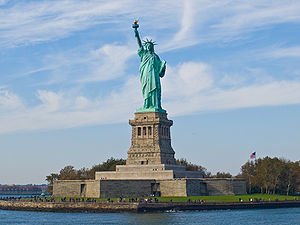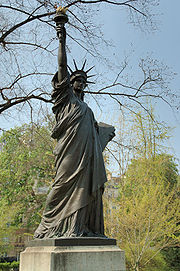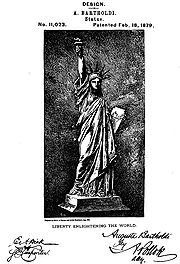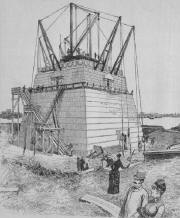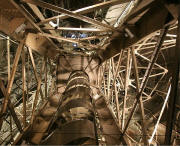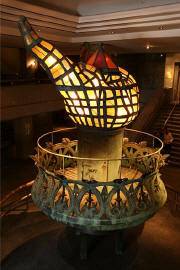Statue of Liberty Information
New York Information Topics
Home > Articles > Statue of Liberty
From Wikipedia, the free encyclopedia
| Statue of Liberty National Monument | |
|---|---|
| Location | Liberty Island, New York, U.S. |
| Nearest city | New York |
| Area | 12 acres (49,000 m²) |
| Established | Statue dedicated October 28, 1886; National Monument established October 15, 1924 |
| Visitors | 4,235,595 (includes Ellis Island NM) (in 2005) |
| Governing body | National Park Service |
The Statue of Liberty (French: Statue de la Liberté), or, more formally, Liberty Enlightening the World (French: La liberté éclairant le monde), was presented to the United States by the people of France in 1886. Standing on Liberty Island in New York Harbor, it welcomes visitors, immigrants, and returning Americans traveling by ship. The copper-clad statue, dedicated on October 28, 1886, commemorates the centennial of the signing of the United States Declaration of Independence and was given to the United States to represent the friendship established during the American Revolution. Frédéric Auguste Bartholdi sculpted the statue and obtained a U.S. patent for its structure. Maurice Koechlin - chief engineer of Gustave Eiffel's engineering company and designer of the Eiffel Tower - engineered the internal structure. Eugène Viollet-le-Duc was responsible for the choice of copper in the statue's construction and adoption of the repoussé technique, where a malleable metal is hammered on the reverse side.
The statue is of a robed woman holding a torch, and is made of a sheeting of pure copper, hung on a framework of steel (originally puddled iron) with the exception of the flame of the torch, which is coated in gold leaf (originally made of copper and later altered to hold glass panes). It stands atop a rectangular stonework pedestal with a foundation in the shape of an irregular eleven-pointed star. The statue is 151 ft (46 m) tall, but with the pedestal and foundation, it is 305 ft (93 m) tall.
Worldwide, the Statue of Liberty is one of the most recognizable icons of the United States and was, from 1886 until the jet age, often one of the first glimpses of the United States for millions of immigrants after ocean voyages from Europe. Visually, the Statue of Liberty appears to draw inspiration from il Sancarlone or the Colossus of Rhodes.
The statue is the central part of Statue of Liberty National Monument, administered by the National Park Service.
The general appearance of the statue’s head approximates the Roman Sun-god Apollo or the Greek Sun-god Helios as preserved on an ancient marble tablet (today in the Archaeological Museum of Corinth, Corinth, Greece) - Apollo was represented as a solar deity, dressed in a similar robe and having on its head a "radiate crown" with the seven spiked rays of the Helios-Apollo's sun rays, like the Statue's nimbus or halo. The ancient Colossus of Rhodes, one of the Seven Wonders of the Ancient World, was a statue of Helios with a radiate crown. The Colossus is referred to in the 1883 sonnet The New Colossus by Emma Lazarus. Lazarus's poem was later engraved on a bronze plaque and mounted inside the Statue of Liberty in 1903.
The statue, also known affectionately as "Lady Liberty", has become a symbol of freedom and democracy. She welcomed arriving immigrants, who could see the statue as they arrived in the United States. There is a version of the statue in France given by the United States in return.
The classical appearance (Roman stola, sandals, facial expression) derives from Libertas, ancient Rome's goddess of freedom from slavery, oppression, and tyranny. Her raised right foot is on the move. This symbol of Liberty and Freedom is not standing still or at attention in the harbor, it is moving forward, as her left foot tramples broken shackles at her feet, in symbolism of the United States' wish to be free from oppression and tyranny. The seven spikes on the crown epitomize the Seven Seas and seven continents. Her torch signifies enlightenment. The tablet in her hand represents knowledge and shows the date of the United States Declaration of Independence, in roman numerals, July IV, MDCCLXXVI.
History
Discussions in France over a suitable gift to the United States to mark the Centennial of the American Declaration of Independence were headed by the politician and sympathetic writer of the history of the United States, édouard René de Laboulaye. French sculptor Frédéric Bartholdi was commissioned to design a sculpture with the year 1876 in mind for completion. The idea for the commemorative gift then grew out of the political turmoil which was shaking France at the time. The French Third Republic was still considered as a "temporary" arrangement by many, who wished a return to monarchism, or to some form of constitutional authoritarianism such as they had known under Napoleon. The idea of giving a colossal representation of republican virtues to a "sister" republic across the sea served as a focus for the republican cause against other politicians.
The first model, on a small scale, was built in 1870. This first statue is now in the Jardin du Luxembourg in Paris.
A second model, also on a small scale, was further brought to Maceió, a city in the Northeast of Brazil. This model is in front of Maceió's first city hall, built in 1869, which is now a museum.
While on a visit to Egypt that was to shift his artistic perspective from simply grand to colossal, Bartholdi was inspired by the project of the Suez Canal which was being undertaken by Count Ferdinand de Lesseps, who later became a lifelong friend of his. He envisioned a giant lighthouse standing at the entrance to the canal and drew plans for it. It would be patterned after the Roman goddess Libertas, modified to resemble a robed Egyptian peasant, a fallaha, with light beaming out from both a headband and a torch thrust dramatically upward into the skies. Bartholdi presented his plans to the Egyptian Khedive, Isma'il Pasha, in 1867 and, with revisions, again in 1869, but the project was never commissioned because of financial issues the country was going through.
It was agreed that in a joint effort, the American people were to build the base, and the French people were responsible for the Statue and its assembly in the United States. In France, public donations, various forms of entertainment including notably performances of La liberté éclairant le monde (Liberty enlightening the world) by soon-to-be famous composer Charles Gounod at Paris Opera, and a charitable lottery were among the methods used to raise the 2,250,000 francs ($250,000). In the United States, benefit theatrical events, art exhibitions, auctions and prize fights assisted in providing needed funds.
Meanwhile in France, Bartholdi required the assistance of an engineer to address structural issues associated with designing such a colossal copper sculpture. Gustave Eiffel (designer of the Eiffel Tower) was commissioned to design the massive iron pylon and secondary skeletal framework which allows the Statue's copper skin to move independently yet stand upright. Eiffel delegated the detailed work to his trusted structural engineer, Maurice Koechlin.
Bartholdi had initially planned to have the statue completed and presented to the United States on July 4, 1876, but a late start and subsequent delays prevented it. However, by that time the right arm and torch were completed. This part of the statue was displayed at the Centennial Exposition in Philadelphia, where visitors were charged 50 cents to climb the ladder to the balcony. The money raised this way was used to start funding the pedestal.
On June 30, 1878, at the Paris Exposition, the completed head of the statue was showcased in the garden of the Trocadéro palace, while other pieces were on display in the Champs de Mars.
Back in America, the site, authorized in New York Harbor by an act of Congress, 1877, was selected by General William Tecumseh Sherman, who settled on Bartholdi's own choice, then known as Bedloe's Island (named after Isaac Bedloe), where there was already an early 19th century star-shaped fortification named Fort Wood. United States Minister to France Levi P. Morton hammered the first nail in the construction of the statue.
On February 18, 1879, Bartholdi was granted a design patent, U.S. Patent D11,023 , on "a statue representing Liberty enlightening the world, the same consisting, essentially, of the draped female figure, with one arm upraised, bearing a torch, and while the other holds an inscribed tablet, and having upon the head a diadem, substantially as set forth." The patent described the head as having "classical, yet severe and calm, features," noted that the body is "thrown slightly over to the left so as to gravitate upon the left leg, the whole figure thus being in equilibrium," and covered representations in "any manner known to the glyptic art in the form of a statue or statuette, or in alto-relievo or bass-relief, in metal, stone, terra-cotta, plaster-of-paris, or other plastic composition."
The financing for the statue was completed in France in July 1882.
Fund-raising for the pedestal, led by William M. Evarts, was going slowly, so publisher Joseph Pulitzer (who established the Pulitzer Prize) opened up the editorial pages of his newspaper, The World, to support the fund raising effort in 1883. Pulitzer used his newspaper to criticize both the rich, who had failed to finance the pedestal construction, and the middle class who were content to rely upon the wealthy to provide the funds. His campaign was an important contribution to the effort, but ultimately Senator Evarts and the American Committee he headed raised the majority of funds for the pedestal.
The construction of the statue was completed in France in July 1884.
The cornerstone of the pedestal, designed by American architect Richard Morris Hunt, was laid on August 5, 1884, but the construction had to be stopped by lack of funds in January 1885. It was resumed on May 11, 1885 after a renewed fund campaign by Joseph Pulitzer in March 1885. Thirty-eight of the forty-six courses of masonry were yet to be built.
The statue arrived in New York Harbor on June 17, 1885 on board the French frigate Isère. To prepare for transit, the Statue was reduced to 350 individual pieces and packed in 214 crates. (The right arm and the torch, which were completed earlier, had been exhibited at the Centennial Exposition in Philadelphia in 1876, and thereafter at Madison Square in New York City.)
Financing for the pedestal was completed on August 11, 1885 and construction was finished on April 22, 1886. When the last stone of the pedestal was swung into place the masons reached into their pockets and showered into the mortar a collection of silver coins.
Built into the pedestal's massive masonry are two sets of four iron girders, connected by iron tie beams that are carried up to become part of Eiffel's framework for the statue itself. Thus Liberty is integral with her pedestal.
The statue, which was stored for eleven months in crates waiting for its pedestal to be finished, was then reassembled in four months. On October 28, 1886, the Statue of Liberty was unveiled by President Grover Cleveland in front of thousands of spectators. (Cleveland, as Governor of the State of New York, had earlier vetoed a bill by the New York legislature to contribute $50,000 to building of the pedestal.)
The Statue of Liberty functioned as a lighthouse from 1886 to 1902. At that time the U.S. Lighthouse board was responsible for its operation. There was a lighthouse keeper and the electric light could be seen for 24 miles (39 km) at sea. As a lighthouse, it is the first to use electricity; there was also an electric plant on the island to generate power for the light.
In 1913 a group of young pilots graduated from the Moissant School of Aviation based on Long Island. One of the graduates, the Mexican pilot Juan Pablo Aldasoro was selected to perform the first flight above the Statue of Liberty. All of the graduates later on became members of the Early Birds of Aviation.
In 1916, floodlights were placed around the base of the statue. Also in 1916, the Black Tom explosion caused $100,000 worth of damage ($1.98 million in 2008 dollars) to the statue, embedding fragmentation and eventually leading to the closing of the torch to visitors. The same year, Gutzon Borglum, sculptor of Mount Rushmore, modified the original copper torch by cutting away most of the copper in the flame, retrofitting glass panes and installing an internal light. After these modifications, the torch severely leaked rainwater and snowmelt, accelerating corrosion inside the statue. President Franklin D. Roosevelt rededicated the Statue of Liberty on its 50th anniversary (October 28, 1936).
In 1956, through an act of Congress, Bedloe's Island was officially renamed Liberty Island, though Liberty Island had been used informally since the turn of the century.
As with all historic areas administered by the National Park Service, Statue of Liberty National Monument, along with Ellis Island and Liberty Island, was listed on the National Register of Historic Places on October 15, 1966.
In 1972, President Richard M. Nixon dedicated the American Museum of Immigration, housed in structural additions to the base of the pedestal on top of what was Fort Wood.
In 1984, the Statue of Liberty was added to the list of World Heritage Sites.
In 2007, the Statue of Liberty was one of 20 finalists in a competition to name the New Seven Wonders of the World.
Inspiration for the face
Unsubstantiated sources cite different models for the face of the statue. One indicated the then-recently widowed Isabella Eugenie Boyer, the wife of Isaac Singer, the sewing-machine industrialist. "She was rid of the uncouth presence of her husband, who had left her with only his most socially desirable attributes: his fortune and -- his children. She was, from the beginning of her career in Paris, a well-known figure. As the good-looking French widow of an American industrialist she was called upon to be Bartholdi's model for the Statue of Liberty." Another source believed that the "stern face" belonged to Bartholdi's mother, Charlotte Bartholdi (1801-1891), with whom he was very close. National Geographic magazine also pointed to his mother, noting that Bartholdi never denied nor explained the resemblance.
Physical characteristics
The interior of the statue used to be open to visitors. They arrived by ferry and could climb the circular single-file stairs (limited by the available space) inside the metallic statue, exposed to the sun out in the harbor (the interior reaching extreme temperatures, particularly in summer), and about 30 people at a time could fit up into the crown. This provided a broad view of New York Harbor (it faces the ocean) through 25 windows, the largest approximately 18" (46 cm) in height. The view did not, therefore, include the skyline of New York City. The wait outside regularly exceeded three hours, excluding the wait for ferries and ferry tickets.
The green-blue coloration is caused by chemical reactions, which produced copper salts and created the current hue. Most copper statues in the outside elements, left to their own, will eventually turn this color in a process called patination.
There are 354 steps inside the statue and its pedestal, with 25 windows in the crown which comprise the jewels beneath the seven rays of the diadem. The tablet which the statue holds in her left hand reads, in Roman numerals, "July 4, 1776" the day of the adoption of the Declaration of Independence.
The Statue of Liberty was engineered to withstand heavy winds. Winds of 50 miles per hour cause the Statue to sway 3 inches (7.62 cm) and the torch to sway 5 inches (12.7 cm). This allows the Statue to move rather than break in high wind load conditions.
Origin of the copper
Historical records make no mention of the source of the copper used in the Statue of Liberty. In the village of Visnes in the municipality of Karmøy, Norway, tradition holds that the copper came from the French-owned Visnes Mine. Ore from this mine, refined in France and Belgium, was a significant source of European copper in the late nineteenth century. In 1985, Bell Labs used emission spectrography to compare samples of copper from the Visnes Mines and from the Statue of Liberty, found the spectrum of impurities to be very similar, and concluded that the evidence argued strongly for a Norwegian origin of the copper. Other sources say that the copper was mined in Nizhny Tagil. The copper sheets were created in the workshops of the Gaget-Gauthier company, and shaped in the Ateliers Mesureur in the west of Paris in 1878. Funding for the copper was provided by Pierre-Eugène Secrétan.
Liberty centennial
The Statue of Liberty was one of the earliest beneficiaries of a cause marketing campaign. A 1983 promotion advertised that for each purchase made with an American Express card, American Express would contribute one penny to the renovation of the statue. The campaign generated contributions of $1.7 million to the Statue of Liberty restoration project. In 1984, the statue was closed so that a $62 million renovation could be performed for the statue's centennial. Chrysler chairman Lee Iacocca was appointed by President Reagan to head the commission overseeing the task (but was later dismissed "to avoid any question of conflict" of interest). Workers erected scaffolding around the statue, obscuring it from public view until the rededication on July 3, 1986 — the scaffolding-clad statue can be seen in the 1984 film Desperately Seeking Susan, in the 1985 film Remo Williams: The Adventure Begins, and in the 1985 film Brewster's Millions. Inside work began with workers using liquid nitrogen to remove seven layers of paint applied to the interior of the copper skin over the decades. That left two layers of tar originally applied to plug leaks and prevent corrosion. Blasting with baking soda removed the tar without further damaging the copper. Larger holes in the copper skin had edges smoothed then mated with new copper patches.
Each of the 1,350 shaped iron ribs backing the skin had to be removed and replaced. The iron had experienced galvanic corrosion wherever it contacted the copper skin, losing up to 50% of its thickness. Bartholdi had anticipated the problem and used an asbestos/pitch combination to separate the metals, but the insulation had worn away decades before. New bars of stainless steel bent into matching shapes replaced the iron bars, with Teflon film separating them from the skin for further insulation and friction reduction.
The internal structure of the upraised right arm was reworked. The statue was erected with the arm offset 18" (0.46 m) to the right and forward of Eiffel's central frame, while the head was offset 24" (0.61 m) to the left, which had been compromising the framework. Theory held that Bartholdi made the modification without Eiffel's involvement after seeing the arm and head were too close. Engineers considered reinforcements made in 1932 insufficient and added diagonal bracing in 1984 and 1986 to make the arm structurally sound.
Besides the replacement of much of the internal iron with stainless steel and the structural reinforcement of the statue itself, the restoration of the mid-1980s also included the replacement of the original torch with a replica, replacing the original iron stairs with new stairs, installing a newer elevator within the pedestal, and upgrading climate control systems. The Statue of Liberty was reopened to the public on July 5, 1986.
New torch
A new torch replaced the original in 1986, which was deemed beyond repair because of the extensive 1916 modifications. The 1886 torch is now in the monument's lobby museum. The new torch has gold plating applied to the exterior of the "flame," which is illuminated by external lamps on the surrounding balcony platform.
Dominion resolved by default
In 1987 Representative Frank J. Guarini, a Democrat from New Jersey, and Gerald McCann, who was Mayor of Jersey City, sued New York City, contending that New Jersey should have dominion over Liberty Island because it is in the New Jersey portion of the Hudson River. The federally owned island is about 2,000 feet away from Jersey City and over two miles from New York City. By default—since the court chose not to hear the case—the existing legal status of the portions of the island that are above water was left unchanged. The riparian rights to all of the submerged land surrounding the statue belong to New Jersey, however. The islands of New York harbor have been part of New York since the issuance in 1664 of the atypical colonial charter that created New Jersey, which failed to provide a boundary in the middle of the Hudson river—although the boundary line for the water rights later was moved to the middle of the channel.
The federal park service states that the Statue of Liberty is on Liberty Island, which is a federal property that is administered by the National Park Service and that, officially, the island is located within the territorial jurisdiction of the state of New York because of a pact between the state governments of New York and New Jersey that declared a resolution to this issue, which was ratified by Congress in 1834.
Aftermath of 9/11
Liberty Island closed on September 11, 2001; the island reopened in December, the monument reopened on August 3, 2004, but the statue has remained closed. The National Park Service claims that the statue is not shut because of a terrorist threat, but principally because of a long list of fire regulation contraventions, including inadequate evacuation procedures. The museum and ten-story pedestal are open for visitors but are only accessible if visitors have a "Monument Access Pass" which is a reservation that visitors must make in advance of their visit and pick up before boarding the ferry. There are a maximum of 3,000 passes available each day (with a total of 15,000 visitors to the island daily). The interior of the statue remains closed, although a glass ceiling in the pedestal allows for views of Eiffel's iron framework.
Visitors to Liberty Island and the Statue are subject to restrictions, including personal searches similar to the security found in airports.
The Statue of Liberty had previously been threatened by terrorism, according to the FBI. On February 18, 1965, the Federal Bureau of Investigation (FBI) announced it had uncovered a plot by three commandos from the Black Liberation Front, who were allegedly connected to Cuba, and a female co-conspirator from Montreal connected with the Front de libération du Québec (FLQ), seeking independence for Quebec from Canada, who were sent to destroy the statue and at least two other national monuments — the Liberty Bell in Philadelphia and the Washington Monument in Washington, D.C.
In June 2006, a bill, S. 3597, was proposed in Senate which, if approved, could re-open the crown and interior of the Statue of Liberty to visitors. In July 2007, a similar measure was proposed in the House of Representatives.
On August 9, 2006, National Park Service Director Fran P. Mainella, in a letter to Congressman Anthony D. Weiner of New York stated that the crown and interior of the statue would remain closed indefinitely. The letter stated that "the current access patterns reflect a responsible management strategy in the best interests of all our visitors." Critics contend that closing the Statue of Liberty indefinitely is an overreaction, and that safe access could easily be resumed under tighter security measures.
On January 23, 2009, Ken Salazar, Secretary of the Interior under President Barack Obama has stated that he is considering reopening the Statue of Liberty's crown to tourists. "I hope we can find a way," Salazar said in a statement. "It would proclaim to the world -- both figuratively and literally -- that the path to the light of liberty is open to all."
Jumps
At 2:45 p.m. on February 2, 1912, steeplejack Frederick R. Law successfully performed a parachute jump from the observation platform surrounding the torch. It was done with the permission of the army captain administering the island. The New York Times reported that he "fell fully seventy-five feet [ m] like a dead weight, the parachute showing no inclination whatsoever to open at first", but he then descended "gracefully", landed hard, and limped away.
The first suicide was May 13, 1929. The Times reported a witness as saying the man, later identified as Ralph Gleason, crawled out through one of the windows of the crown, turned around as if to return, "seemed to slip" and "shot downward, bouncing off the breast of the statue in the plunge." Gleason was killed when he landed on a patch of grass at the base, just a few feet from a workman who was mowing the grass.
On August 23, 2001, French stuntman Thierry Devaux parasailed onto the monument and got hung up on the statue's torch in a bungled attempt to bungee jump from it. He was not hurt and was charged with four misdemeanor offenses including trespassing.
Inscription
The interior of the pedestal contains a bronze plaque inscribed with the poem "The New Colossus" by Emma Lazarus. It has never been engraved on the exterior of the pedestal, despite such depictions in editorial cartoons.
Not like the brazen giant of Greek fame,
With conquering limbs astride from land to land;
Here at our sea-washed, sunset gates shall stand
A mighty woman with a torch, whose flame
Is the imprisoned lightning, and her name
Mother of Exiles. From her beacon-hand
Glows world-wide welcome; her mild eyes command
The air-bridged harbor that twin cities frame.
"Keep, ancient lands, your storied pomp!" cries she
With silent lips. "Give me your tired, your poor,
Your huddled masses yearning to breathe free,
The wretched refuse of your teeming shore.
Send these, the homeless, tempest-tossed to me,
I lift my lamp beside the golden door!"
The bronze plaque in the pedestal contains a typographical error: the comma in "Keep, ancient lands" is missing, causing that line to read "'Keep ancient lands, your storied pomp!' cries she", and noticeably altering its meaning.
Replicas and derivative works
Hundreds of other Statues of Liberty have been erected worldwide.
Boy Scouts of America placed a small-scale replica of the Statue of Liberty at the Gentry Building in Columbia, Missouri in 1950. Located at the Parks & Recreation Administration Offices, at 7th and Broadway, the plaque notes that the statue was dedicated as a pledge of everlasting fidelity and loyalty. The local project was a component of the Scouts' national 40th anniversary celebration which had Strengthen the Arm of Liberty as its theme. More than 200 replicas were placed nationally as a result.
There is also a replica statue in the middle of the Susquehanna River near Harrisburg, PA. The statue is almost entirely white as viewed from US-322 East and West going past the river. Another replica, in Cape Girardeau, Missouri, stands at the entrance of Capaha Park.
There is a sister statue in Paris and several others elsewhere in France, including one in Bartholdi's home town of Colmar, erected in 2004 to mark the centenary of Bartholdi's death; they also exist in Austria, Germany, Italy, Japan, China, Brazil and Vietnam; one existed in Hanoi during French colonial days. There are replicas in theme parks and resorts, including the New York-New York Hotel & Casino in Las Vegas on the Strip, replicas created as commercial advertising, and replicas erected in U.S. communities by patriotic benefactors, including no less than two hundred donated by Boy Scout troops to local communities.During the Tiananmen Square protest of 1989, Chinese student demonstrators in Beijing built a 10 m image called the Goddess of Democracy, which sculptor Tsao Tsing-yuan said was intentionally dissimilar to the Statue of Liberty to avoid being "too openly pro-American." At around the same time, a copy of this statue was made and displayed on Connecticut Avenue in Washington, DC, in a small park across the street from the Chinese Embassy.
The sculptor James Alexander Ewing's most prestigious commission was for the carving of the Glasgow City Chambers' Jubilee Pediment, its apex group of Truth, Riches and Honour, and the statues of The Four Seasons on the building's tower. The figure of Truth is also known as Glasgow's Statue of Liberty, due to its close resemblence to the similarly posed, but very much larger, statue in New York harbour.
In popular culture
The Statue of Liberty quickly became a popular icon, featured in scores of posters, pictures, motion pictures, and books. A 1911 O. Henry story relates a fanciful conversation between "Mrs. Liberty" and another statue; it figured in 1918 Liberty Loan posters. During the 1940s and 1950s, pulp Science Fiction magazines featured Lady Liberty surrounded by ruins or by the sediments of the ages.
It has been in dozens of motion pictures. It is a setting in the 1942 Alfred Hitchcock movie Saboteur, which featured a climactic confrontation at the statue. Half submerged in the sand, the Statue provided the apocalyptic revelation at the end of 1968's Planet of the Apes. The statue became a character in the 1989 film, Ghostbusters II, in which it comes to life and helps defeat the evil villain, and was the setting for the climax of the first X-Men film. It can also be seen lying broken on the ground in the movie Independence Day, after the first wave of attacks by the extra-terrestrial biological beings from outer space. In the 2004 movie The Day After Tomorrow, the statue gets frozen, and in the 2008 movie Cloverfield, it is decapitated by a giant monster; its head lands in a Manhattan street. In the film, National Treasure: Book of Secrets, the sister statue in Paris provides a clue.
It was the subject of a 1978 University of Wisconsin-Madison prank in which Lady Liberty appeared to be standing submerged in a frozen-over local lake. It has appeared on New York and New Jersey license plates, is used as a logo for the NHL's New York Rangers and the WNBA's New York Liberty, and it was the subject of magician David Copperfield's largest vanishing act.
The statue is often used as a comparative measurement (usually referring to height rather than length) in books and documentaries.
New York Information Topics



